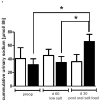Sodium and water handling after gastric bypass surgery in a rat model
- PMID: 20570570
- PMCID: PMC3715839
- DOI: 10.1016/j.soard.2010.03.286
Sodium and water handling after gastric bypass surgery in a rat model
Abstract
Background: It was the aim to investigate the influence of gastric bypass on renal sodium and water handling. The relationship between sodium and water absorption along the gastrointestinal tract and their renal excretion is poorly understood. Beneficial effects on blood pressure have been seen after bariatric surgery before significant weight loss has occurred.
Methods: Male Wistar rats (348 ± 19 g) underwent either gastric bypass (n = 14) or sham operation (n = 7) and were given a low-sodium diet with deionized water ad libitum. Before and after surgery, the rats received an oral sodium load (1.5 mmol/kg) as hyperosmolar saline (616 mM), and were then placed in individual metabolic cages so the urine volume, sodium content, and water intake for 8 hours could be recorded. The urine sodium concentration was also measured.
Results: The rats that had undergone gastric bypass had a significantly lower body weight than the sham-operated controls throughout the follow-up period (346 ± 21 g versus 501.3 ± 8.0 g at day 60; P = .0004). An oral sodium load after gastric bypass led to an increase in water intake (.07 ± .01 mL/g versus .03 ± .01 mL/g; P = .023), urine output (.03 ± .01 mL/g versus .02 ± .002 mL/g; P = .027), and sodium excretion (65.99 ± 10.7 mol versus 31.71 ± 8.7 mol; P = .020). No change was seen in water intake, urine output, or sodium excretion after sham surgery.
Conclusion: Urine output, water intake, and sodium excretion are all increased after gastric bypass surgery in rats given an oral sodium load compared with sham-operated controls. More rapid excretion, and less retention, of a dietary sodium load could be a part of the mechanism underlying the beneficial effect of bariatric surgery on blood pressure.
Copyright © 2011 American Society for Metabolic and Bariatric Surgery. Published by Elsevier Inc. All rights reserved.
Figures









Similar articles
-
Gastric bypass increases energy expenditure in rats.Gastroenterology. 2010 May;138(5):1845-53. doi: 10.1053/j.gastro.2009.11.012. Epub 2009 Nov 18. Gastroenterology. 2010. PMID: 19931268
-
The Short-Term Effects of Roux-en-Y Gastric Bypass on Renal Excretion of Sodium and Its Association with Blood Pressure.Obes Surg. 2020 Jan;30(1):102-110. doi: 10.1007/s11695-019-04134-6. Obes Surg. 2020. PMID: 31515727 Clinical Trial.
-
Steatorrhea and hyperoxaluria occur after gastric bypass surgery in obese rats regardless of dietary fat or oxalate.J Urol. 2013 Sep;190(3):1102-9. doi: 10.1016/j.juro.2013.02.3229. Epub 2013 Mar 14. J Urol. 2013. PMID: 23499748 Free PMC article.
-
Feeding behavior and body weight development: lessons from rats subjected to gastric bypass surgery or high-fat diet.J Physiol Pharmacol. 2009 Dec;60 Suppl 7:25-31. J Physiol Pharmacol. 2009. PMID: 20388943 Review.
-
Catabolic effects of gastric bypass in a diet-induced obese rat model.Curr Opin Clin Nutr Metab Care. 2006 Jul;9(4):423-35. doi: 10.1097/01.mco.0000232903.04910.7b. Curr Opin Clin Nutr Metab Care. 2006. PMID: 16778572 Review.
Cited by
-
Gastrointestinal-Renal Axis: Role in the Regulation of Blood Pressure.J Am Heart Assoc. 2017 Mar 6;6(3):e005536. doi: 10.1161/JAHA.117.005536. J Am Heart Assoc. 2017. PMID: 28264861 Free PMC article. Review. No abstract available.
-
Gastric bypass in obese rats causes bone loss, vitamin D deficiency, metabolic acidosis, and elevated peptide YY.Surg Obes Relat Dis. 2014 Sep-Oct;10(5):878-84. doi: 10.1016/j.soard.2014.01.021. Epub 2014 Jan 28. Surg Obes Relat Dis. 2014. PMID: 24969093 Free PMC article.
-
Roux-en-Y gastric bypass operation in rats.J Vis Exp. 2012 Jun 11;(64):e3940. doi: 10.3791/3940. J Vis Exp. 2012. PMID: 22710348 Free PMC article.
-
Lessons learned from gastric bypass operations in rats.Obes Facts. 2011;4 Suppl 1(Suppl 1):3-12. doi: 10.1159/000327301. Epub 2011 Mar 31. Obes Facts. 2011. PMID: 22027283 Free PMC article. Review.
-
Using Animal Models to Determine the Role of Gustatory Neural Input in the Control of Ingestive Behavior and the Maintenance of Body Weight.Chemosens Percept. 2015 Aug;8(2):61-77. doi: 10.1007/s12078-015-9190-y. Epub 2015 Aug 13. Chemosens Percept. 2015. PMID: 26557212 Free PMC article.
References
-
- Buchwald H, Avidor Y, Braunwald E, et al. Bariatric surgery: a systematic review and meta-analysis. JAMA. 2004;292:1724–37. - PubMed
-
- Sjostrom L, Lindroos AK, Peltonen M, et al. Lifestyle, diabetes, and cardiovascular risk factors 10 years after bariatric surgery. N Engl J Med. 2004;351:2683–93. - PubMed
-
- Sjostrom L, Narbro K, Sjostrom CD, et al. Effects of bariatric surgery on mortality in Swedish obese subjects. N Engl J Med. 2007;357:741–52. - PubMed

